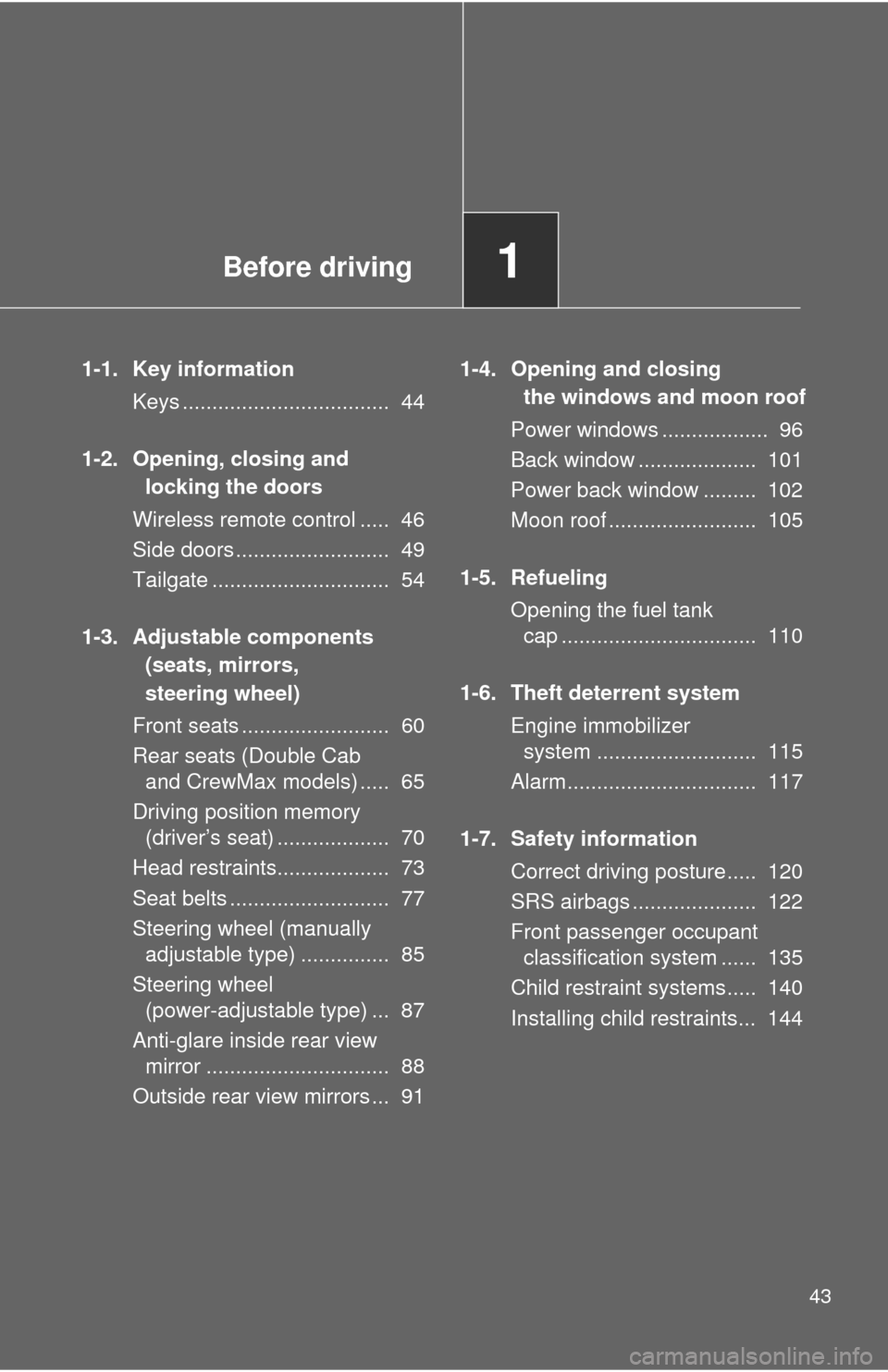Page 2 of 744

TABLE OF CONTENTSIndex
2
1-1. Key informationKeys ..................................... 44
1-2. Opening, closing and locking the doors
Wireless remote control ....... 46
Side doors ............................ 49
Tailgate ................................ 54
1-3. Adjustable components (seats, mirrors, steering
wheel)
Front seats ........................... 60
Rear seats (Double Cab and CrewMax models) ....... 65
Driving position memory (driver’s seat) ..................... 70
Head restraints ..................... 73
Seat belts ............................. 77
Steering wheel (manually adjustable type) .................. 85
Steering wheel (power-adjustable type)...... 87
Anti-glare inside rear view mirror .................................. 88
Outside rear view mirrors ..... 91
1-4. Opening and closing the windows and moon roof
Power windows .................... 96
Back window ...................... 101
Power back window ........... 102
Moon roof ........................... 105 1-5. Refueling
Opening the fuel tank cap... 110
1-6. Theft deterrent system Engine immobilizer system .............................. 115
Alarm .................................. 117
1-7. Safety information Correct driving posture ....... 120
SRS airbags ....................... 122
Front passenger occupant classification system ......... 135
Child restraint systems ....... 140
Installing child restraints ..... 144
2-1. Driving procedures Driving the vehicle .............. 168
Engine (ignition) switch....... 178
Automatic transmission ...... 181
Turn signal lever ................. 186
Parking brake ..................... 187
Horn .................................... 188
2-2. Instrument cluster Gauges and meters ............ 189
Indicators and warning lights ................................. 195
Multi-information display ..... 200
Accessory meter ................. 207
1Before driving
2When driving
Page 5 of 744

1
2
3
4
5
6
7
5
4-1. Maintenance and careCleaning and protecting the vehicle exterior............ 526
Cleaning and protecting the vehicle interior............. 529
4-2. Maintenance Maintenance requirements ..................... 532
General maintenance.......... 534
Emission inspection and maintenance (I/M)
programs........................... 537
4-3. Do-it-yourself maintenance Do-it-yourself service precautions ....................... 538
Hood ................................... 542
Engine compartment ........... 543
Tires .................................... 557
Tire inflation pressure ......... 565
Wheels ................................ 569
Air conditioning filter............ 572
Wireless remote control battery ............................... 575
Checking and replacing fuses ................................. 577
Light bulbs........................... 588 5-1. Essential information
Emergency flashers............ 600
If your vehicle needs to be towed........................... 601
If you think something is wrong ............................... 607
Fuel pump shut off system .............................. 608
5-2. Steps to take in an emergency If a warning light turns on or a warning buzzer
sounds... .......................... 609
If a warning message is displayed (vehicles
with multi-information
display) ............................. 619
If you have a flat tire ........... 623
If the engine will not start.... 641
If the shift lever cannot be shifted from P ................... 643
If you lose your keys........... 646
If the vehicle battery is discharged........................ 647
If your vehicle overheats .... 651
If the vehicle becomes stuck ................................. 654
If your vehicle has to be stopped in
an emergency .................. 655
4Maintenance and care5When trouble arises
Page 40 of 744

40
CAUTION
■General precautions while driving
Driving under the influence: Never drive your vehicle when under the influ-
ence of alcohol or drugs that have impaired your ability to operate your vehi-
cle. Alcohol and certain drugs delay reaction time, impair judgment and
reduce coordination, which could lead to an accident that could result in
death or serious injury.
Defensive driving: Always drive defensively. Anticipate mistakes that other
drivers or pedestrians might make and be ready to avoid accidents.
Driver distraction: Always give your full attention to driving. Anything that dis-
tracts the driver, such as adjusting controls, talking on a cellular phone or
reading can result in a collision with resulting death or serious injury to you,
your occupants or others.
■ General precaution regarding children’s safety
Never leave children unattended in the vehicle, and never allow children to
have or use the key.
Children may be able to start the vehicle or shift the vehicle into neutral.
There is also a danger that children may injure themselves by playing with
the windows, or other features of the vehicle. In addition, heat build-up or
extremely cold temperatures inside the vehicle can be fatal to children.
Page 43 of 744

Before driving1
43
1-1. Key informationKeys ................................... 44
1-2. Opening, closing and locking the doors
Wireless remote control ..... 46
Side doors .......................... 49
Tailgate .............................. 54
1-3. Adjustable components (seats, mirrors,
steering wheel)
Front seats ......................... 60
Rear seats (Double Cab and CrewMax models) ..... 65
Driving position memory (driver’s seat) ................... 70
Head restraints................... 73
Seat belts ........................... 77
Steering wheel (manually adjustable type) ............... 85
Steering wheel (power-adjustable type) ... 87
Anti-glare inside rear view mirror ............................... 88
Outside rear view mirrors ... 91 1-4. Opening and closing
the windows and moon roof
Power windows .................. 96
Back window .................... 101
Power back window ......... 102
Moon roof ......................... 105
1-5. Refueling Opening the fuel tank cap ................................. 110
1-6. Theft deterrent system Engine immobilizer system ........................... 115
Alarm................................ 117
1-7. Safety information Correct driving posture..... 120
SRS airbags ..................... 122
Front passenger occupant classification system ...... 135
Child restraint systems..... 140
Installing child restraints... 144
Page 44 of 744
44
1-1. Key information
Keys
■When required to leave a key to the vehicle with a parking attendant
Lock the glove box as circumstances demand. ( P. 463)
■ Key number plate
Keep the plate in a safe place such as your wallet, not in the vehicle. In the
event that a key is lost, a new key can be made by your Toyota dealer using
the key number plate. ( P. 646)
The following keys are provid ed with the vehicle.
Vehicles without engine immobilizer system
Master keys
Key number plate
Vehicles with engine immobilizer system Master keys
Key number plate
Page 45 of 744
45
1-1. Key information
1
Before driving
NOTICE
■
To prevent key damage (vehicles with engine immobilizer system)
● Do not subject the keys to strong shocks, expose them to high tempera-
tures by placing them in direct sunlight, or get them wet.
● Do not expose the keys to electromagnetic materials or attach any mate-
rial that blocks electromagnetic waves to the key surface.
Page 47 of 744

47
1-2. Opening, closing and locking the doors
1
Before driving
■
Wireless remote control battery depletion
The standard battery life is 1 to 2 years. (The battery becomes depleted
even if the wireless remote control is not used.) If the wireless remot\
e control
function does not operate, the battery may be depleted. Replace the battery
when necessary. ( P. 575)
■ If the wireless remote control does not operate
Locking and unlocking the doors: Use the key. ( P. 49)
■ Security feature
If a door is not opened within approximately 60 seconds after the vehicle is
unlocked, the security feature automatically locks the vehicle again.
■ Alarm (if equipped)
Using the wireless remote control to lock the door will set the alarm sy\
stem.
(P. 117)
■ Conditions affecting operation
The wireless remote control function may not operate normally in the follow-
ing situations.
●Near a TV tower, radio station, electr ic power plant, airport or other facil-
ity that generates strong radio waves
● When carrying a portable radio, cell ular phone or other wireless commu-
nication device
● When multiple wireless keys are in the vicinity
● When the wireless key has come into contact with, or is covered by a
metallic object
● When a wireless key (that emits radio waves) is being used nearby
● When the wireless key has been left near an electrical appliance such as
a personal computer
■ When riding in an aircraft
When bringing a wireless remote control onto an aircraft, make sure you do
not press any buttons on the wireless remote control while inside the aircraft
cabin. If you are carrying a wireless remote control in your bag etc, ensure
that the buttons are not likely to be pressed accidentally. Pressing a button
may cause the wireless remote control to emit radio waves that could inter-
fere with the operation of the aircraft.
Page 49 of 744
49
1
1-2. Opening, closing and locking the doors
Before driving
Side doors
The vehicle can be locked and unlocked using the wireless remote
control, key or door lock switch.
■Wireless remote control (if equipped)
P. 4 6
■ Key
Vehicles without power door lock system
Locks the door
Unlocks the door
Vehicles with power door lock system Locks all doors
Unlocks all doors
Turning the key a single time in
the driver’s door unlocks the
driver’s door, and turning the
key again unlocks the other
doors.
Vehicles with moon roof
Closes the moon roof
(turn and hold)
Opens the moon roof
(turn and hold)